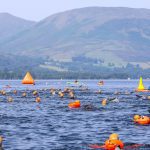Ask the Experts: Drafting
I am repeatedly taken aback by how much easier it is to swim in someone’s slipstream. Swimming in a pool with a metronome, I realised I was actually going surprisingly quickly, although I felt like I was doing virtually nothing. Given the loss of relationship between perceived exertion and speed when drafting, how do you suggest estimating your speed (in order to decide whether to continue to draft or to accelerate past)?
Eerke Berger
Dan says: Drafting can be an amazing tool in your ‘open water swimming tool kit’. It can also be a hindrance. How come? The best story I have been told is that of the open water swimmer who drafted off another swimmer… the only problem was the other swimmer wasn’t in the event! By the time the ‘drafter’ figured this out they were miles off course. Another significant issue can be pace – drafting off someone who is going slower than your ideal pace. In this instance you would still be getting the efficiency benefit of the slipstream but of course you are swimming below your ideal pace.
So how to best use drafting to your advantage, including knowing you are swimming at your best pace? Like anything in swimming – practice, practice and practice is paramount. To get best return for your drafting first know your race pace. How? It starts with your training in the pool. Repeat times, tempo trainers, repeat sets and consistency. All of these build fitness, endurance and an innate knowledge of what your ideal pace feels like and what it feels like to perfectly push your limits, maintaining your threshold pace without ‘blowing up’! You should also practise drafting off others when you are training. Like any other swim skill the more you rehearse the better you’ll get at it.
Drafting, used correctly, will help improve your performance; to achieve your best possible performance using drafting you should swim at your OPTIMUM race effort while in the draft situation. This will mean that when drafting you are swimming above your rehearsed pace but with your normal ‘race pace’ energy output. In action this requires your ideal draftee to be swimming slightly faster than your race pace. However, there is no way to measure this in a race situation. A reasonable test you can use is to pop sideways out of the draft of the swimmer to see what the pace feels like when you’re not drafting. Be quick though, if you fall behind you may not be able to get back into the ‘slot’. The reality is if you know your race pace well enough and you have rehearsed drafting regularly you will know when drafting is the best option and when it is not. Just remember to ensure whomever you are drafting is swimming in the right direction!
Dan Abel is an open water coach in New Zealand and the UK. In New Zealand he pioneers sportive swimming through RealSwim Adventures.








